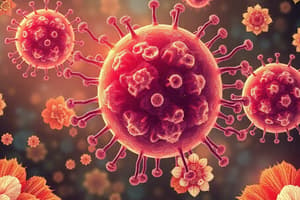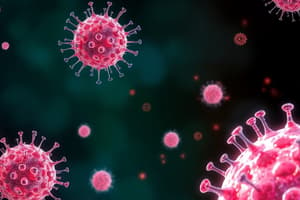Podcast
Questions and Answers
What is the primary function of cytotoxic T cells?
What is the primary function of cytotoxic T cells?
- Enhance cytokine production
- Present antigens to other immune cells
- Stimulate antibody production
- Destroy virus-infected cells (correct)
Which component released by CD8 T cells helps induce apoptosis in target cells?
Which component released by CD8 T cells helps induce apoptosis in target cells?
- Cytokines
- Perforin
- Antibodies
- Granzymes (correct)
What mechanism is primarily involved in the action of perforin?
What mechanism is primarily involved in the action of perforin?
- Enhancing antibody production
- Formation of pores in cell membranes (correct)
- Inhibition of cytokine secretion
- Directly inducing apoptosis
Which of the following statements about CD4 and CD8 T cell cooperation is correct?
Which of the following statements about CD4 and CD8 T cell cooperation is correct?
What is a characteristic trait of CD8 T cells regarding their ability to kill target cells?
What is a characteristic trait of CD8 T cells regarding their ability to kill target cells?
Which proteins work together with perforin to enhance its effectiveness against target cells?
Which proteins work together with perforin to enhance its effectiveness against target cells?
What trait do cytokines exhibit concerning their function in the immune response?
What trait do cytokines exhibit concerning their function in the immune response?
Which T cell subset is primarily associated with the clearance of intracellular pathogens?
Which T cell subset is primarily associated with the clearance of intracellular pathogens?
Flashcards are hidden until you start studying
Study Notes
Antigen Recognition by T Cells
- CD4 and CD8 T cells recognize antigens presented by MHC molecules
- CD4 T cells interact with MHC class II molecules, primarily expressed by antigen-presenting cells
- CD8 T cells interact with MHC class I molecules, expressed on all nucleated cells
Intracellular Pathogens: Cytokine vs Cytotoxicity
- CD8 T cells are essential for controlling intracellular pathogens like viruses and some bacteria
- CD8 T cells can either release cytokines to activate other immune cells or directly kill infected cells through cytotoxicity
Activation of CD8 T Cells
- Strong co-stimulation is required for CD8 T cell activation
- Co-stimulation signals are provided by molecules like CD28 on T cells interacting with CD80 or CD86 on antigen-presenting cells
Cytotoxic T Cells
- Cytotoxic T cells (CTLs) destroy virus-infected cells
- CTLs release cytotoxic molecules to kill target cells
Cytotoxic T Cells: Killing Mechanism
- Perforin forms pores in the target cell membrane
- Granzymes enter the cytoplasm of the target cell, causing apoptosis
- Granulysin works with perforin and serglycin to form pores in the target cells
Clearance of a Pathogen
- CD4 T cells cooperate with CD8 T cells to clear pathogens
- CD4 T cells provide signals and cytokines that support the differentiation and function of CD8 T cells
Helper T Cell Responses
- Th1 cells primarily help in the clearance of intracellular pathogens
- Th1 cells secrete cytokines like IFN-γ, which activates macrophages and promotes CD8 T cell cytotoxicity
- Th2 cells mainly help in the clearance of parasitic infections
- Th2 cells secrete cytokines like IL-4 and IL-5, which stimulate IgE production and eosinophil activation
- Th17 cells are involved in the defense against extracellular bacteria and fungi
- Th17 cells secrete cytokines like IL-17, which recruit neutrophils to the site of infection
Summary of Effector Cell Influences on Host Cells
- CD4 and CD8 T cells are crucial for adaptive immunity
- They coordinate immune responses against different pathogens
- Their roles can be categorized as cytokine production or cytotoxicity
Comparison of Antibodies and TCR
- Antibodies are produced by B cells and recognize extracellular antigens in their native form
- TCRs are expressed by T cells and recognize antigen fragments presented by MHC molecules
- Antibodies can neutralize pathogens and toxins, while TCRs primarily activate T cells to produce cytokines or kill infected cells
Primary and Secondary Response to Infection
- Primary immune responses have a lag before detectable antibodies appear
- Secondary immune responses are faster and more robust due to the presence of memory B cells
- Memory B cells are generated during the primary response and quickly differentiate into antibody-producing plasma cells upon re-exposure to the same antigen
Studying That Suits You
Use AI to generate personalized quizzes and flashcards to suit your learning preferences.




